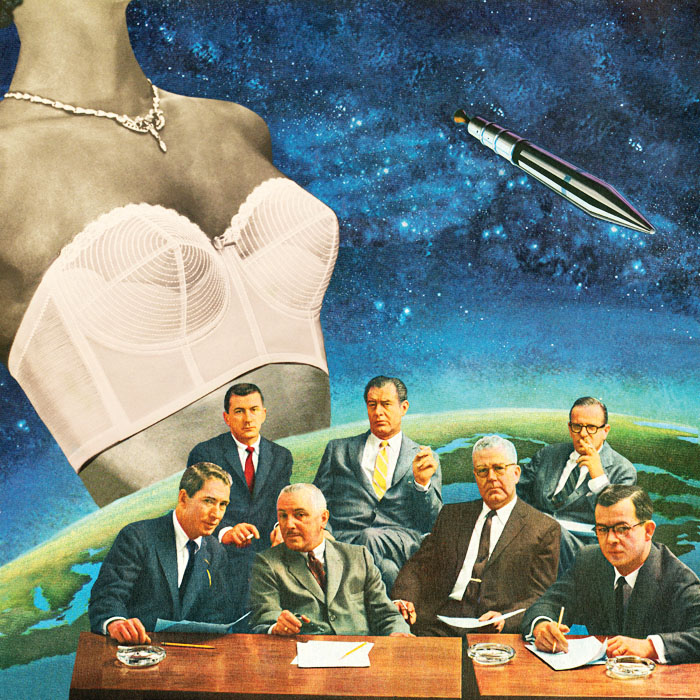Three Perspectives on Outspoken: Seven Women Photographers
Venus Rising, one collage from the series “Fortune and the Feminine.”
Outspoken: Seven Women Photographers is a photography exhibition which was featured in the Tremaine Gallery this past month, ending this past Sunday. In addition to the exhibition, five of the featured photographers spoke on a panel last Thursday for the Prep and Lower Mid humanities and upper-level photography students. In this issue, three student photographers share their impressions of the show and talk.
Nicholas Lorentzen ’20
What injustices do women face in our society? Curator Marky Kauffman presents her answers in Outspoken. Featuring seven women photographers, including Kauffman, the exhibit focused on photographs that highlight the struggles that women face in our society. While most of the pieces chose to focus on the earlier stages of life, Kauffman’s pieces brought attention to a generally neglected topic – the social pressure on older women to fight aging with cosmetic treatments. In her series, “Lost Beauty,” Kauffman began with classic black and white portraits of women, who all met her singular criterion: being over the age of 60. After creating silver prints, Kauffman applied the chemical potassium ferricyanide with brushes or spray bottles. The bronze patterns created by the various tools starkly contrasted with the otherwise monotone palette of the portraits. In the panel talk, Kauffman explained that the corrosive properties of the potassium ferricyanide mimics the processes some women undergo when they use dangerous chemicals and procedures to alter their appearance. The end result is a fascinating print that is also aesthetically pleasing.
Jerry Sheng ’20
In Outspoken, as Kauffman said in the show’s statement, the seven photographers aimed to “ask the viewer to question assumptions about what is fair, right, or possible for women and girls” by focusing on females of various ages and backgrounds.
“Cheyenne River” a series by Emily Schiffer, for instance, focuses on young girls on a reservation in South Dakota. In this series, six black-and-white prints show the life of youths in Cheyenne River, capturing the natural actions of children climbing big tires, stepping into a pond, and lying in the sand. When talking about her attraction to black-and-white photography, Shiffer said, “I find color to be a distraction from light, facial expressions, and visual nuances. [Black-and-white] takes you directly into the moment.”
One of the most valuable parts of this exhibit is that, unlike shows which focus on a single artist, Outspoken emphasizes the relationships between multiple photographic perspectives. I was not only impressed by how diverse the forms of art presented were but also how tightly they related to one other. From “Lost Beauty” to “Growing up Girl: Together and Alone,” each artist perfectly portrayed groups of females of diverse ages, races, and backgrounds.
Jiahua Chen ’20
Without a doubt, Outspoken constituted a superb demonstration of art that advocates a social cause. Whether it be unrealistic expectations of aging or childhood on an indigenous reservation, Outspoken captured women’s diverse experiences. I commend the seven women photographers represented in this exhibition. Outspoken should not pass without criticism, however, and it is regrettably its exact purpose that distances pieces in the exhibit from becoming masterpieces. In the oversaturated field of social photography, Outspoken veered toward becoming yet another hackneyed attempt to tug at audiences’ heartstrings and inspiring social change. The pieces, for example – Marky Kauffmann’s disfigured elderly faces,Tira Khan’s documentation of girlhood, Blake Fitch’s enchanting portraits of dress-up princesses, Nancy Grace Horton’s portrayal of women’s roles, Rania Matar’s exploration of the abodes of teenage girls, Emily Schiffer’s depiction of indigenous childhood, and Nadine Boughton’s stunning collages – eventually boiled down to the same message: the empowerment of women through artwork. Many of the pieces inevitably became one-sided and lacked the layers of sophistication that really could have given them the wow factor. I was moved by their message, but that’s it. I simply wished art in this genre could do more to inspire audiences to be enchanted into a trance of empathy.






